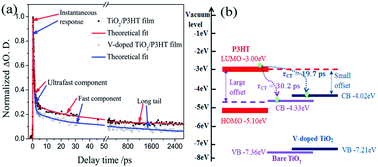Efficiency enhancement via tailoring energy level alignment induced by vanadium ion doping in organic/inorganic hybrid solar cells†
Abstract
Photovoltaic performances are critically dependent on efficient photoexcited charge carrier generation. Vanadium ions are introduced into titanium dioxide (TiO2) as a photocatalyst to tailor the energy level alignment of TiO2 and the conjugated polymer poly(3-hexylthiophene) (P3HT). Incorporation of vanadium ions into TiO2 yields a remarkable decrease of the energy offset between the conduction band edge of TiO2 and the lowest unoccupied molecular orbital of P3HT. The reduction of the ‘excess’ energy offset leads to a faster electron transfer at the interface of the bulk heterojunction with the lifetime decreasing from 30.2 to 19.7 ps, thus giving rise to a notable enhancement of the photovoltaic performance. That is, a power conversion efficiency of 3.01% for the vanadium-doped TiO2/P3HT solar cell at 5.0 wt% vanadium-doping is obtained as compared to 2.00% for pure TiO2.


 Please wait while we load your content...
Please wait while we load your content...